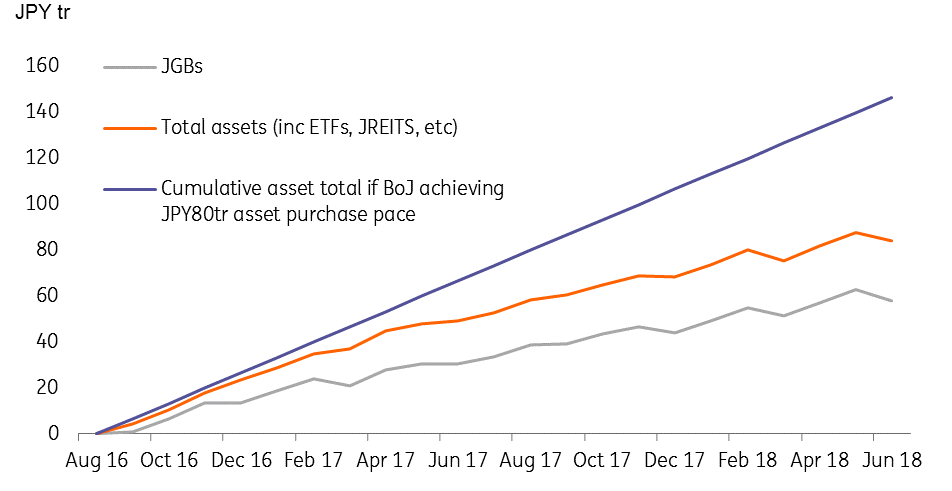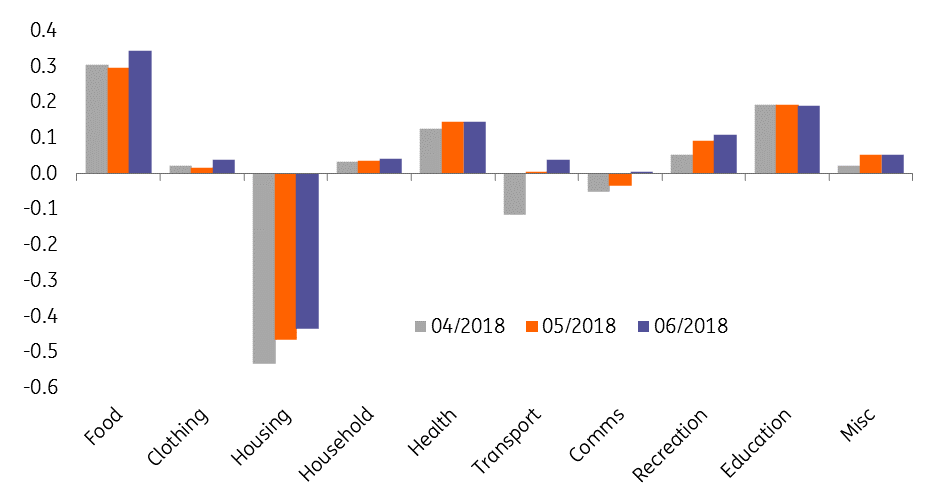Stealth normalization
Of all the market moves in the panoply of markets forecasts, I bet few had anticipated a global yield curve steepening, driven by a long-tenor JGB sell-off. This is unlikely to last. The next Bank of Japan rate meeting is on 31 July.
BoJ Asset purchases - cumulative, compared to JPY80tr target pace

This is only a market squeeze, unless the BoJ delivers next week
Honestly, I didn't imagine I would be talking about the Bank of Japan (BoJ) as the lead story in one of my daily rambles when I pre-wrote my monthly Japan economic update at the end of last week (pre-wrote as am heading off on vacation for 2-weeks). There had been some chatter about a change in policy following the April meeting's omission of any reference to meeting the 2% inflation target by 2019. That should not have startled anyone. The lowest forms of animal life on the planet stopped believing the BoJ's inflation target some years ago.
But somehow, the story seems to have lingered. Japanese newspapers have been carrying stories talking about the possibility of an (unspecificed) change in the BoJ's policy stance on 31 July.
I don't see it myself. The BoJ is known for its so-called "kite-flying" exercises. As the mere rumour of a policy change has sent 10Y Japanese Government Bond (JGB ) yields soaring above 0.1% (last seen early Feb this year - so not exactly an unprecedented level), the likelihood of them following through with any concrete change in policy is, in my opinion, extremely low.
I certainly don't think abandoning, or amending the BoJ policy targets, including inflation, are on the table. But the official pace of asset purchasing might be. As the BoJ is consistently under-buying assets compared to its stated pace of about JPY80tr per annum, a low-cost move might be to simply officialize this under-buying at its current rate, approximately JPY45tr p.a. Should the BoJ wish to moderate its stimulus still further, it can covertly lower its actual asset purchasing still further, say to JPY25tr, or some other rate consistent with maintaining JGB yields "close to" zero., Even this "close to" can get diluted over time. If markets get used to 0.1% as meaning "close to zero" then in time that will become the new zero, just as JPY45tr has become the new JPY80tr.
"Stealth normalization" - clever huh? The same notion as boiling a frog by slowly heating up the water, The frog doesn't notice. This apparently is untrue, however. Please don't boil frogs or any other amphibians.
Contributions to YoY% Singapore CPI growth

The downside of a weaker currency - higher inflation, weaker domestic growth
Singapore's headline inflation nudged up to 0.6%YoY in June, but the core rate rose too, now reaching 1.7%YoY, a considerably stronger result than had been expected, The cause? Well a breakdown of the components of Singapore's CPI shows that basically everything is either slightly more positive, or slightly less negative. It wouldn't surprise us to find that the SGD's recent USD weakness had led to some import of inflation. Singapore's import price inflation is now running a little over 6.5%YoY. 3 months ago, it was less than zero. It isn't just Singapore. This is an Asia-wide phenomenon. And it has implications. Central Banks may respond with tighter policy relative to the counterfactual of stable currencies. I don't anticipate the MAS tightening their nominal effective currency target path further in October as a result. But higher inflation might prevent them from reversing their April 2018 tightening decision.
Asian Import Price inflation rising on weaker currencies

This publication has been prepared by ING solely for information purposes irrespective of a particular user's means, financial situation or investment objectives. The information does not constitute investment recommendation, and nor is it investment, legal or tax advice or an offer or solicitation to purchase or sell any financial instrument. Read more
Download
Download opinion
24 July 2018
Good MornING Asia - 24 July 2018 This bundle contains 2 Articles